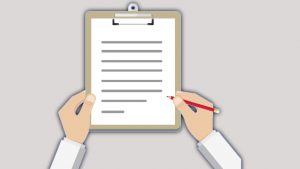How to Take Notes While Reading a Textbook: Note taking is an indispensable study skill. Often, students are in the habit of copying large portions of their textbooks into their notebooks in the name of note taking. This is certainly not note taking. Many others also concentrate on the writing of the notes such that when they are through with the note taking process, they can recall only little or nothing from the notes they have taken because they did not pay any attention to the content or information contained in the textbook. Rather, their whole efforts were channeled towards writing. Thus, they have not maximized the time for note taking to learn.

Efficient note taking requires an active participation of the brain such that the student learns even as they are taking notes.
Recommended: Differences between note taking and note making
Ways to take notes while reading
Here are a few tips on how to efficiently take notes while reading your textbooks:
1. Put the information in your own words: for efficient note taking, there is need for you to understand the content of the textbooks, interpret the information contained in it and reproduce that information in your own words and not copying the author word for word.
By rephrasing or rewording the information garnered from a textbook in your own vocabulary, that is, words that you are conversant with, you task your brain to process the novel contents of the textbook and find a relation between it and other things that you already know of.

This may not be as easy as it may seem because sometimes, you may not be able to find words in your vocabulary bank to replace some of the strange words and terminologies that you may come across in your textbook. To overcome this challenge, you will have to first of all, understand the information contained in the text, then relate it to something you are familiar with.
There is no need to rephrase key terms or facts as you would be required to supply them that way when you are quizzed about them.
2. Clearly outline what you want to learn from the textbook: If you do not know what you are looking for, you will end up beating about the bush in futility. By writing out what exactly it is you hope to get from the textbook, you would know what parts of the textbook to read and which ones to ignore.
To achieve this, you can draft some questions or points of interest that will serve as a reading guide for you. You can also peruse the syllabus or course outline of the course as well as past question papers and notes taken from lectures to help streamline your reading.

When you are done making notes, be sure to cross check your notes against these bullet points or questions to be sure that you cover everything that is required of you.
Also see: How to be a good teacher to your students
3. Make a sketch of the key headings or units that make up the textbook: by skimming through the book chapter by chapter, writing down the headings and subheadings, you can come up with an outline of the main contents of the textbook.
While reading the textbook you can write a summary at the end of each subheading or heading. Do this until you cover the whole part of the textbook that you have to read. This is a more efficient and easier way than reading whole chapters and going back to summarize them.
Be sure to keep the notes short. You can make use of the Cornell note writing style or whichever one that works for you. This will help you to compress large portions of data into concise information that contains all that you need to know minus the frivolous stuff.
4. Leaf through the textbook while making mental notes of where the most important information are. You need not even go through the book page by page. You can just skim through the introduction and conclusion to get an idea of what that section is about and know if it contains the information that you are looking for.
Also see: Signs to know an intelligent person
5. Read a section and write your notes from memory: this is an excellent way of memorizing what you are studying. When you know that you would have to reproduce these content from your memory, it will trigger your brain to store that content not just for that moment but also for the future when you would be required to supply it in an exam or test.
As effective and efficient as this is, it is also easy. Just read a section of the textbook then close the textbook and make all the notes you can on that section from your memory. Thereafter, you can cross-check your note against what you have in the textbook for inaccuracies or mistakes or those information you could not recall before you move on to another section and repeat the process.
6. Pay attention to graphs and charts: as much as you would want to skip these, you must know that they can house information that might be useful for your notes. Besides they are mostly summaries of large portions of information which you would miss out in your notes if you do not study the charts, maps or graphs.
Recommended: Advantages and Disadvantages of learning online
7. Add little diagrams or sketches: be as creative as you can be but be careful not to make this the bulk of your note. These should just be visual hints on what a particular section or the other is all about.
You will know you have a good understanding of a portion of the textbook if you are able to translate complicated information into simple, easy to understand diagrams.
8. Use colour to point out the important details: using colorful notes or pens in highlighting your notes will induce your brain to pay attention to those information in the notes and recall them easily by associating them with the colours that they were written in.
However, you must ensure that you do not overdo it by using too many different colours or covering every word in your notebook with colour.
RECOMMENDED: Advantages and Disadvantages of shopping online
9. Make your notes as compact as possible: this is because the lesser the pages of notes you have to revise, the more likely you are to remember what you studied. Besides, you do not want to start reading hundreds of pages again when you want to revise so cut out all the superfluous details and put down only the important points in your note book.
10. Go over your notes for mistakes: accuracy is key here. You do not want a note full of incorrect or vague content. This is why you need to check your notes very well to be sure that the information in it is accurate and error free.
Check spellings of terminologies, names of key figures, dates and so on. Also, check your summaries against the original words of the author to ensure that the information in your note book tallies with or mirrors what you have in the textbook and that it is written in clear, comprehensible language that you can easily get the gist of when you read it weeks later for that exam.
Recommended: How to read and understand faster
Note taking while reading a textbook need not be an uphill task if you do it the right way. You would only be wasting your study time for nothing if you follow the traditional methods of copying chunks of your textbook verbatim into your note. You do not task your brain to think or try to remember anything. Indeed, it would be better for you to just read directly from your textbook for your test or exams.
With these tested and trusted tips on how to take notes while reading a textbook, you are sure to save your self time and energy while making waves in your studies– a win- win situation! However, you might want to be flexible with these tips as there is no hard and fast way to studying. Experiment with them to find out what works for you.

Edeh Samuel Chukwuemeka, ACMC, is a lawyer and a certified mediator/conciliator in Nigeria. He is also a developer with knowledge in various programming languages. Samuel is determined to leverage his skills in technology, SEO, and legal practice to revolutionize the legal profession worldwide by creating web and mobile applications that simplify legal research. Sam is also passionate about educating and providing valuable information to people.